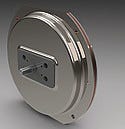March 26, 2010
|
Printed Motor Works' redesigned pancake motor achieves rapid acceleration and deceleration, while providing low inertia and high torque ratios. |
Printed armature motors--also known as pancake or servodisc dc motors--have been around for decades, but they recently underwent a transformation. In the hands of Printed Motor Works, the technology has been substantially revamped, resulting in easier installation, quieter operation, and a more-compact design.
Pancake motors have long been admired for their compact size and features. Smaller and thinner than normal iron-core motors, they provide low inertia and high torque ratios, resulting in acceleration from 0 to 3000 rpm in 60°. To achieve such rapid acceleration and deceleration, printed motors can handle a peak current of up to 10 times the continuous rating--a performance level unachievable by iron-core motors without demagnetizing.
Once considered cost-prohibitive for many applications, the redesigned pancake motor can now be considered a realistic alternative to conventional dc and universal electric motors, according to Simon Peaty, Printed Motor Works' sales engineer. "We have reviewed and improved everything in the construction, from replacing metal parts with high-specification injection-molded engineering plastics to conducting lengthy studies into graphite compositions to ensure that product life is optimized."
Replacing metal parts with engineered-plastic components has enabled the company to flatten the motor by moving the bearing pockets inside the housing and integrating several other separate parts into one molding. "This change," Peaty says, "has allowed us to increase the efficiency with which these motors are produced, meaning the product can break through from niche into mainstream applications."
Graphite-composite studies conducted by the company have resulted in motors that run at higher torque for longer periods without compromising motor life, according to Peaty. These studies involved the use of copper-loaded, silver-loaded, and high-graphite-content brushes in which control motors were run for set periods at high loads.
As a direct-drive solution, the redesigned motor puts out 40 to 1600 W of power and runs at speeds ranging from 50 to more than 6000 rpm. Because of its varied features, it is suitable for different medical device applications. In functional MRI scanners, it offers instant torque delivery, while in blood centrifuges, wheel drives, and automated sample-analysis instruments, it can be employed for its compact size.
The motor's flat profile is a space-saving feature that manifests itself in a number of ways, Peaty says. "The machine can be made shorter or thinner, depending on the orientation of the application; servicing is simplified, since the compact assembly can be removed easily in the field; and machine assembly can be simplified, since the thin motor can be slipped into the machine frame with ease."
Printed Motor Works
Alton, Hampshire, UK
www.printedmotorworks.com
You May Also Like



